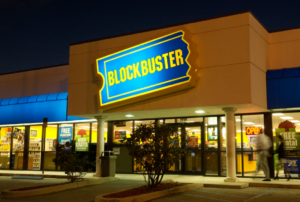Large companies that do not introduce innovations risk disappearing. That is the hard truth in the digital age.
Many of you will remember big companies like Atari, Kodak, Nokia, Blockbuster, Pan Am, among many others. All burst by advances in the binary world and changes in consumer behavior.
Survival, in the field of large companies, depends to a large extent on their ability to adapt to the constant cultural and technological transformations. If one analyzes the Fortune 500 ranking, which lists the most important companies in the world since 1955 in terms of sales, it will be able to understand that it is not so easy to adapt to the demands of supply and demand during such long periods, in which they produce transformations in production processes, updates in market strategies and technological leaps.
Only 61 companies from the original list are listed in the 2017 ranking, which means that 80% of large organizations disappeared. What do the companies that are on the list have in common? These companies have managed to survive the ravages of time mainly because of their commitment to innovation, a concept that has become the pillar of all the ventures of these big companies. Therefore, those that stopped figuring, stopped being innovative.
What happened to these big companies? What prevented them from continuing to innovate in their products and / or services?
There are 5 examples of companies that disappeared because they stop being innovative, remember which ones are:
1. Atari The company was born in 1972 but the success came five years later, hand in hand with the Atari 2600 console. It sold more than 42 million units worldwide. However, by 1982, the company went through a crisis that could never be recovered: that Christmas launched “E.T. the Extra-Terrestrial “, considered the worst game in history.
What happened? In 1976, after being acquired by Warner, the company focused on the sale of consoles rather than the development of video games. Of producing classics like “Space Invaders”, “Donkey Kong” and Pac Man “, Atari was relegated with the appearance of Nintendo and Sega, who released Super Mario Bross (1985) and The Legend of Zelda (1986). Atari Jaguar (1993) was the last console that launched Atari. It was a failure.

2. Kodak Eastman Kodak Company was founded in 1881 under an innovative concept: to simplify the process of printing plates to take photographs. For 1888 Kodak launched the Folding Pocket, the first pocket camera, with replaceable film cartridges, introducing the common man to the world of photography ever since. In the seventies, 90% of the movies sold in the United States were Kodak and a similar percentage corresponded to the cameras. But, for 2012, the company declared bankruptcy.
What happened? Kodak created the first digital camera in 1975, but as they had a monopoly on film rolls, they felt that it was not wise to develop this product commercially at that time. It was his worst decision. LG, Sony, Samsung and Panasonic finished their monopoly in less than two years.
3. Nokia For fourteen consecutive years, Nokia was the leading brand in mobile telephony in the world. So profitable was the company that the parent company, located in Finland, and came to contribute 25% of the country’s economic growth between 1998 and 2007. However, for 2011, lost more than 40% of the global market.
What happened? On January 9, 2007 Steve Jobs introduced the iPhone, and, in 2008, the Android operating system was launched. While Nokia focused on its E and N series to compete with Blackberry in the segment of executives and businessmen, smartphones monopolized the market for millennials and digital natives, generations that used cell phones to interact in social networks. Today Nokia, in terms of brand, is a franchise, which will return to the market hand in hand with the company HMD Global Oy (HMD).

4. Blockbuster It opened its first store in 1985. The business model was simple: rental of original videos in a modern and attractive place. In 1994, with a growing millionaire business, the company was acquired by Viacom, owner of Paramount Pictures, Dreamworks and MTV Networks, for 8.4 billion dollars. At the beginning of the 21st century, despite piracy, Blockbuster was still a power, but the advent of broadband internet quickly became a threat.
What happened? In the year 2000 Blockbuster received the proposal to share synergies with Netflix, a small company that rented movies through postal mail. Netflix, for the modest sum of 50 million dollars, offered the company to join efforts to grow in the streaming format, but Blockbuster was not interested in the proposal. Your argument: it does not make sense to pay an unlimited subscription because the business is in penalties for the delay in return. However, Netflix showed that it was not necessary to have physical stores to rent movies, nor that it was profitable to rent the movies in units. Blockbuster closed its last stores in 2013.

Pan Am Pan American World Airways was the largest airline in the US for decades. It was one of the companies that contributed most to promote transoceanic transport between Europe and America, as well as inaugurating some new lines on the Pacific. But after the oil crisis of ’73, costs began to rise, making the company much less profitable. In addition to the high cost of fuel, demand fell considerably and competition was increasingly harsh.
What did he do wrong? To try to correct the negative trend, Pan Am invested millions in a new fleet of Boeing 747 with the expectation that the demand for transoceanic trips would continue to rise, something that did not happen. To try to compensate the new competition in the international lines, the company tried to operate new national destinations. Pan Am was too specialized in transoceanic flights and in the national market the routes were well covered with companies that had been offering their services for years, so their adaptation was slow. At the same time, those same companies that started with domestic flights were entering the international market, which meant more competition for the company. This situation and the growing terrorist threat (like the Lockerbie bombing in 1988) precipitated the ruin of the company, which declared bankruptcy in 1991.

But why are so many big companies innovating bad?
Traditionally, large companies are much more conservative than small or new generation companies and will not do anything that is not proven or that could risk their future profits. Conversely; Innovation entails risk and your ventures need a very different leadership and mentality, which did not exist in most of these large companies.
Many times companies fear that failure can damage their reputation by “venturing” to innovate, however; they can not afford not to carry out actions in that sense because they would disappear like the examples I mentioned earlier. The world changes with extreme rapidity, and competition threatens to take you out of business.
How can large companies avoid falling behind in innovation?
I decided to take as an example the company General Electric (GE), a multinational with revenues of about $ 150,000 million (USD) and a stock price of more than $ 265,000 million (USD), has incorporated innovation to each part of its business, and that having centers around the world employ thousands of researchers and engineers working in all divisions of the company, one might think that the company would have the innovation part covered.
Nevertheless; The world is moving fast and the digital world is becoming more and more part of the physical world. For this reason; GE has been experimenting with “open innovation”, inviting outside engineers to take part in design competitions.
In 2013, he urged the engineering community to invent a model for 3D printing of lighter and stronger supports for their aircraft engines. In this case, they had about 700 participants from around the world and gave prizes to the best ideas. An Indonesian student managed to reduce the weight by 84%. It’s a great lesson in how you can get ideas quickly.
Definitely outsourcing to innovate in this way is the trend, says Phil Cox, president of the British branch of the company Silicon Valley Bank
“Given the dual pressure of the cost of innovation and the speed at which the economy of innovation is changing, large organizations are taking advantage of open innovation.”
“By partnering with other organizations, from academics to start-up companies, larger companies can introduce new products and strategies more easily and quickly.”
DO YOU WANT TO MAKE A COMMENT ON IT?
